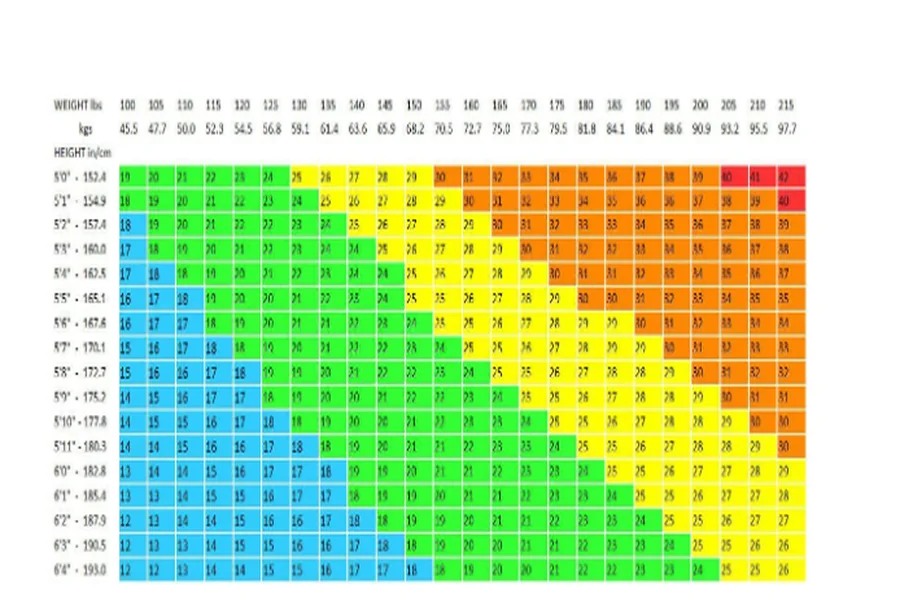When you search for a female height and weight chart, what you’re looking for is often more than just a number on the scale — you want to know if your body is in balance, your health is on track, and if you’re feeling good inside and out.
But behind every chart, ideal range, and BMI calculation lies a deeply human story—one of self-acceptance, struggle, and strength.
In this article, we’ll go beyond the data and explore:
- The science behind the female height and weight chart
- How to interpret how much should I weigh based on body type
- Why health isn’t always about size — but about habits
- And how to find peace with your body while still chasing wellness goals
Let’s dive into the real story behind the stats.
What Is a Female Height and Weight Chart?
A female height and weight chart is a guide that shows the “ideal” or “healthy” weight ranges based on your height. These charts are used by doctors, trainers, and individuals who want to understand their general health status.
Here’s an example of a commonly referenced women’s height-weight chart :
Standard Women’s Height Weight Chart (in pounds)
| HEIGHT | LOW END RANGE | MID-RANGE | HIGH END RANGE |
| 4’10” | 91–115 lbs | 103 lbs | 117–143 lbs |
| 5’0″ | 97–123 lbs | 110 lbs | 125–153 lbs |
| 5’2″ | 104–131 lbs | 118 lbs | 134–164 lbs |
| 5’4″ | 111–140 lbs | 126 lbs | 143–174 lbs |
| 5’6″ | 118–148 lbs | 134 lbs | 152–185 lbs |
| 5’8″ | 125–158 lbs | 142 lbs | 162–197 lbs |
| 5’10” | 132–167 lbs | 150 lbs | 171–209 lbs |
| 6’0″ | 140–177 lbs | 159 lbs | 181–221 lbs |
“You don’t have to chase perfection. You just have to chase progress.”
That kind of wisdom can help you navigate the confusing world of health metrics without losing yourself.
Why Do People Search for “How Much Should I Weigh?”
The question, “How much should I weigh?” comes from a place of curiosity—sometimes insecurity—but often, it’s rooted in a desire to feel strong, balanced, and confident.
Many people use these charts to:
- Set fitness goals
- Track health changes
- Understand how their body compares
- Get a sense of where they stand medically
But here’s the truth:
“Your worth is not measured by numbers. It’s measured by how you treat yourself and others.”
Still, understanding your body composition can be helpful, especially with care and context.
The Science Behind the Numbers
While height-weight charts give a rough idea of ideal weight, they aren’t gospel. Health is more complex than height and weight.
Here’s a quick breakdown of what goes into determining a healthy weight :
| FACTOR | INFLUENCE ON BODY WEIGHT |
| Age | Metabolism slows as you age |
| Muscle Mass | Heavier than fat — but healthier |
| Bone Density | Varies person to person |
| Genetics | Plays a big role in frame size |
| Lifestyle | Diet and movement shape results |
Charts like the BMI calculator and U.S. Army body fat standards offer insight — but they don’t tell your whole story.
“Being ‘normal’ doesn’t mean being happy. Being healthy means being at peace.”
That emotional truth is rare — and part of what makes the conversation around body weight so important.
Types of Height Weight Charts You Might Use
There are several ways to assess how much I should weigh, each with its own strengths and limitations.
Here’s a comparison of the most common methods:
| METHOD | HOW IT WORKS | PROS | CONS |
| Standard Height Weight Chart | Based on old actuarial tables — insurance industry roots | Easy to follow | Doesn’t account for muscle mass |
| BMI (Body Mass Index) | Uses height and weight to calculate ratio | Widely accepted by medical professionals | Can mislabel muscular people as overweight |
| U.S. Army Standards | Measures neck/waist to estimate body fat | More accurate than BMI | Still not perfect for all bodies |
| Hamwi Formula | Calculates ideal weight based on height | Used in healthcare settings | Not personalized |
| Devine Formula | Similar to Hamwi — slightly different | Helps determine drug dosages | Again, not a full picture |
These tools can help guide decisions but shouldn’t define your value.
The Emotional Side of Body Weight
For many, searching for a female height and weight chart is more than just a fitness habit — it’s a way to cope with anxiety, pressure, or even trauma around body image.
One woman shared:
“I used to check the chart every week. I thought if I hit the right number, I’d finally feel okay in my skin.”
Sound familiar?
Weight alone doesn’t define your health or measure your confidence, joy, or purpose.
“It took me years to stop comparing myself to charts and start loving myself.”
That kind of honesty is rare — and powerful.
Finding Your Balance
Instead of obsessing over charts, experts suggest focusing on:
- Energy levels
- Strength and mobility
- Mental clarity
- Bloodwork and markers (cholesterol, blood sugar)
- How your clothes fit — literally and emotionally
Here’s a short checklist to shift focus from numbers to well-being:
| FOCUS AREA | INSTEAD OF… |
| Nutrition | Strict calorie counting |
| Movement | Overtraining or punishment |
| Sleep | Ignoring rest |
| Mental health | Comparing to others |
| Community | Chasing solo transformation |
“You don’t need a chart to feel good. You need a connection to your body and soul.”
That kind of wisdom sets you free — not just from charts, but from self-doubt.
Frequently Asked Questions (FAQ)
Q1: What is a standard female height and weight chart?
A: A height weight chart gives a general range of a healthy weight based on height. Doctors and military recruiters often use it.
Q2: How do I know how much I should weigh?
A: Look at overall health markers — energy, mobility, mental state — rather than just the scale.
Q3: Are height weight charts accurate?
A: They give a ballpark figure, but they don’t consider muscle, bone density, or lifestyle factors.
Q4: Does the military use a female height and weight chart?
A: The U.S. Army uses a height-weight table and body fat percentage to ensure readiness and uniform fit.
Q5: Can I rely on BMI to determine my health?
A: BMI is a starting point — but it doesn’t capture the full picture of health.
Q6: Where can I find a female height and weight chart online?
A: Many sites offer printable charts, including:
Final Thoughts: Beyond the Chart
The female height and weight chart is a tool — not a test.
And “how much should I weigh?” isn’t just a physical question — it’s emotional, too.
True wellness starts when you stop chasing charts — and start listening to your body, your mind, and your heart.
That’s why health isn’t just about fitting a mold. It’s about finding your rhythm.
Follow Wellness Online
Stay updated with new ideas, personal stories, and holistic health tips:
| PLATFORM | ACCOUNT LINK |
| Wellness & Confidence Tips | |
| Women’s Health Empowerment Group | |
| YouTube | Mindful Fitness Channel |
| Twitter/X | Health & Self-Love Tips |



